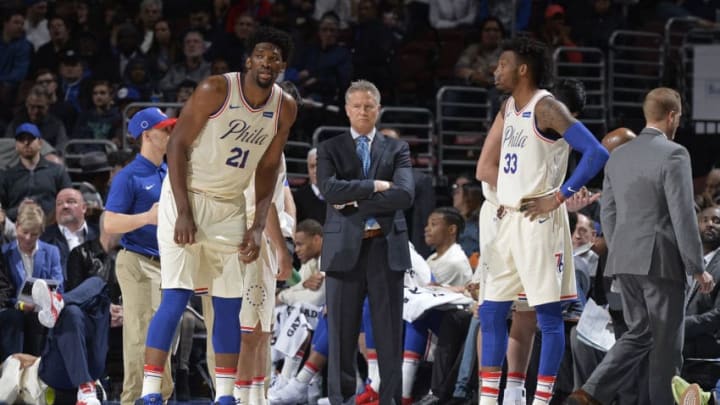There are certain truisms about the NBA playoffs that can fundamentally change the lens through which a team is viewed, regardless of regular season performance: rotations shorten, the game slows down and top-end talent outweighs depth.
Those aphorisms don’t always change the way we think about certain teams, and on many occasions, aren’t necessarily true. But in other instances, they hold real weight, and every year, there seems to be a test case in either conference that puts these axioms to the test. If one team seems primed to shoulder that mantle in 2018, it’s the Philadelphia 76ers, who have one of the best collections of talent in the East and are virtually locked into their first playoff appearance of the Process era.
Philadelphia has far surpassed expectations for a year in which it relies predominantly on young players with minimal NBA experience, never mind dubious health. And yet, it feels as though the Sixers have upward mobility as flexible as that of any in the Eastern Conference. Joel Embiid will likely be the best player in any series not against Cleveland or Milwaukee. He is an inexorable force who almost singlehandedly turns a pathetic team into a dominant one. Philadelphia’s offense with Embiid on the floor measures up with league’s most explosive teams; its defensive rating during that time would lead the entire NBA. But surviving the minutes without Embiid has proven a near-crippling challenge for the 76ers, even with their other four starters on the court. Ben Simmons has become a more capable offensive linchpin when Embiid sits, but those minutes have been tenuous all the same.
Much of that time is borne of necessity; lingering health concerns have reduced Embiid’s availability, and nearly half of the 76ers’ minutes at center have come from inferior options. Brett Brown will be rightfully vigilant about potentially compromising his center’s long-term health, but even three or four additional minutes per game with that sort of two-way anchor on the floor will matter.
Read More: Which draft prospects have the most at stake in the Sweet 16?
Philadelphia has the right dose of shooting, playmaking and defensive versatility around Embiid to maximize him, and vice versa. Simmons is a supersized floor general and a terror in the open court; the threat of J.J. Redick’s jumpshot forces defenses to account for his every movement; Robert Covington is one of the league’s cagiest defenders; Dario Šarić arrhythmically combines all three traits to fill any given gap. Those four and Embiid have outscored opponents by over 17 points per 100 possessions – the third-best mark among groups with at least 250 minutes played – but net positives off the bench have been hard to come by. That margin – while not entirely sustainable in a playoff setting – should hold more firmly with less time for unsuccessful bench units to torpedo it.
Almost invariably, liabilities on either end of the floor become harder to hide in playoff settings. Philadelphia has mustered a top-five defense by overwhelming teams with size and funneling the ball toward Embiid, who redirects forays to the basket or shuts them down entirely. With such a ferocious interior presence insuring a slew of versatile forwards, the Sixers are well-equipped to combat the sorts of mismatch-generating strategies that become more prevalent in the playoffs. There’s no way to prevent being attacked by LeBron James if he chooses to do so, but having switchable players across several positions can at least delay it long enough for the shot clock to impose itself upon the possession.
Philadelphia can also create mismatches of its own; most any action between Simmons and Embiid is bound to produce an advantage in some form or another:
Opponents will dare Simmons to beat them from outside the paint, perhaps to an extreme degree. On his best nights, he barrels toward the rim anyway, kicking out to shooters who punish teams for loading crowding the lane. On others, he crashes into walls of help defense, vexed by the dearth of options before him. Such are the downsides of an offense rooted in inexperience. Philadelphia turns the ball over more frequently than any team in the NBA, a product of its two stars still learning to navigate a league increasingly geared to stop them.
Next: How Fred VanVleet became the NBA's unlikeliest linchpin
The playoffs then, will provide an instructive test of how they handle those magnified challenges against opponents with entire series to target their weaknesses. So far, they’ve stayed ahead of the curve every step of the way, and come April, the 76ers will have a chance to take another precocious leap.
